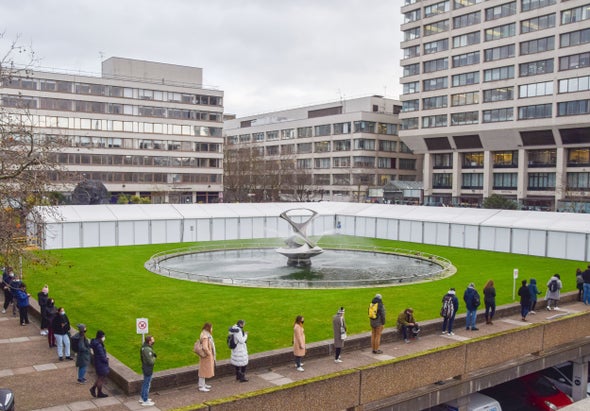Omicron's Endless Mutations to Sub-Variants
"What is happening is you have this large population now that has some significant amount of immune response to the virus, either through previous infections or vaccinations and boosting, or a combination of both.""The virus is mutating in populations that have a fair amount of resistance to earlier forms.""The virus is finding a new niche in humans -- a niche in highly vaccinated, boosted and previously infected people. These are very specific mutations.""[Hospitalizations in Canada are increasing], but again we're not seeing a huge increase in requirement for ventilators or a significant increase in death. Knock on wood that continues.""[A catastrophic variant can't be ruled out] but the way the virus is going, it has spent a lot of ammunition already in mutating its spike protein. I'm not an evolutionary biologist, but it may have gone down that path as far as it can go."Dr.Terrance Snutch, professor, Michael Smith Laboratories, University of British Columbia/ chair, Canadian COVID-19 Genomics Network"[We've treated COVID as the most important health issue of the day for the past two years], and maybe rightly so for a chunk of that. But we can't really be too focused on COVID at the expense of so many other things that we've just ignored over the years. [Delays in cancer surgery, a] humongous [wait list for medical care for just about anything].""None of us, in our lifetimes, have seen any virus that behaves this way. I don't think anybody can predict what we'll be facing in the future."Dr. Sameer Elsayed, infectious diseases specialist, Western University
 |
| Long queue at the St Thomas’s Hospital Vaccination Center in London. The U.K. Government is urging all eligible people to get a booster vaccine as the Omicron variant spreads. Credit: Vuk Valcic/SOPA Images/LightRocket via Getty Images |
Coronavirus cases are on a runaway upward trajectory across parts of Europe in the past two weeks. A "stunning" summer wave is slamming California, while Australians are urged to work from home while hospitals in the country are being swamped with COVID cases. Medical scientists have been stumped by a virus that has failed to reflect the predictable pattern of other viruses, in neat winter-centric waves like the flu. Instead multiple waves keep rolling in, each new variant entering before the previous one has completed its run; no lulls -- with peaks rising within months, one after another.
Even where populations have been vaccinated, boosted, and/or infected in one way or another, including combinations of all three, those surges keep rolling in. Still, scientists demur, it could be worse; given that our "immunity wall" has been useful in responding to each successive variant. BA.5-driven hospitalizations while rising, continue to remain below previous waves, with fewer ICU admissions and deaths.
And now, another sub-variant of Omicron has entered the scene known as BA.2.75 with its own wealth of mutations extending past the mutations first seen in the original version of Omicron BA.1 that lost no time ripping through global populations. According to Dr.Snutch, however, the virus remains essentially the same: "which is to be mutating at a certain rate in populations that are susceptible"; the mutation rate has not if at all, changed much, he contends.
No evidence has yet arisen that BA.4 and BA.5 are the source of more damaging disease outcomes. A study in hamsters, however, suggested that BA.5 can lodge deeper n the lungs. Antibodies neutralizing SARS-CoV-2, preventing infection wear out, but it has been found that the body's T-cells provide longer-lasting memory protection against the virus. Published in March, a study found COVID infection or vaccination produces sustained levels of T cells that can recognize the SARS-Cov-2 spike protein, lasting over a year.
"Even though some parts of the immune response wane, we can now see that T cells recognizing the virus are quite stable over time", explained the study's senior author, Dr.Jennifer Juno, immunologist at University of Melbourne. Following 15 months of monitoring, "they were still roughly ten-fold higher than someone who had never been exposed to the spike protein through infection of vaccination [which might explain why we're not seeing as many severe infections]."
People with Omicron frequently have reported relatively mild symptoms of sore throat, hoarse voice, cough and headache. "If that's the case moving forward, it's endemic as a nuisance more than anything", said Dr.Snutch. "Though a nuisance in older people can be deadly, just like the flu is deadly."
 |
| A pedestrian walks through Pitt Street Mall on July 8 in Sydney, Australia. Residents in NSW are being encouraged to update their COVID-19 vaccinations, wear masks in enclosed spaces, and practice good COVID-safe behaviors, as COVID-19 infections continue to rise across the state, driven by Omicron subvarians. The Australian Technical Advisory Group on Immunisation (ATAGI) announced an expansion in eligibility for a fourth dose of a COVID-19 vaccine, with people aged 30 and over able to access the additional booster shots from July 11 |
"What is the core strategy that will allow Canadians to live as full a life as possible while protecting the things we value, including our elderly and most vulnerable?""The compromise may be that we accept that we have to invest in air quality, and we have to wear masks during periods of high viral spread and keep updated with vaccines to the best extent possible.""People were saying this will be like a seasonal respiratory virus. 'We'll have a great summer and in the fall it will come back'. It's not acting like that. It has these cyclical waves. We're now in July!"Dr. Catherine Hankins, co-chair COVID-19 immunity task force, professor of public and population health, McGill University
Labels: Global Surge, Omicron, SARS-CoV-02, Sub-Variants

0 Comments:
Post a Comment
<< Home